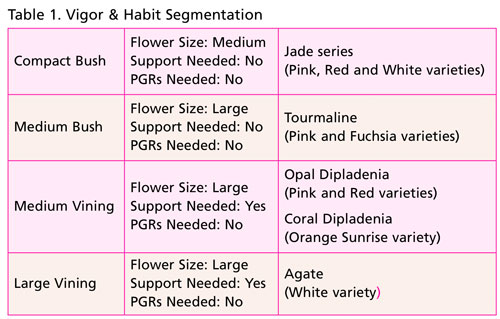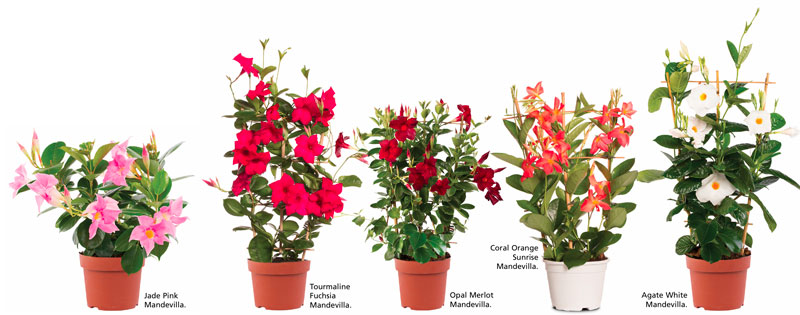6/1/2023
Make It Tropical With Mandevilla
Massy Sanaei

The market for tropicals—and plants that provide consumers with a tropical vibe—is growing strong. It seems gardeners can’t get enough! Even though homeowners are no longer mandated to stay at home and have resumed their personal travel, their backyard and patio designs have become their personal island-getaways and resemble remote destinations.
Now arriving: Mandevilla
One class that effortlessly transports any backyard garden to the tropics is mandevilla. It’s a spectacular genus with more than 100 species. Mandevilla displays different plant habits for any setting, including vining options that can be trained to climb a trellis or privacy wall, and envelop an outdoor space into a leafy green and colorful floral oasis.
In 2021, in order to expand and enrich its tropical breeding program, Ball Horticultural Company and Florensis acquired the Diamantina brand of mandevilla from Lannes Group, a well-respected producer of tropical plants based in France.
Soon after, I made a trip to Spain to see the genetics and I was thoroughly impressed. There were so many novelties within this mandevilla breeding, including colors unique to the class, impressive habits and plant structure. I could easily see the opportunities this breeding offered to fulfill the needs of our greenhouse customers and gardener end-users.
What really stood out to me with these genetics were the stack of flowers displayed on the plants. These aren’t your old-fashioned mandevilla! This is modern breeding, with plenty of flowers at the ready-for-retail stage. No more waiting for blooms to pop. What better way to grab those impulse shoppers than to have tons of tropical flowers ready to turn heads?
 When I returned to the States from my trip to Spain, Ball FloraPlant restructured their mandevilla assortment by plant vigor and habit, arranging them into easy-to-understand categories (Table 1).
When I returned to the States from my trip to Spain, Ball FloraPlant restructured their mandevilla assortment by plant vigor and habit, arranging them into easy-to-understand categories (Table 1).
Besides knowing when to offer trellised support during production, the plant culture is relatively easy. Mandevilla propagates with a rooting hormone in 6 to 8 weeks, with the first 3 weeks required under mist. One pinch in propagation is suggested, as well as one in the finish stage; no PGRs required. Here are a few additional tips:
Jade series: No trellis required
In the compact bush category, the Jade series offers patio gardeners a lush and easy display of flowers in White, Pink and Red varieties on a plant that requires no trellis! Jade finishes with a soil pH of 5.5 to 7.5 at night temperatures of
60 to 70F (21 to 24C).
Most notable for Jade is that although its glossy leaves are small, the flowers are not! This is contrary to typical mandevilla, where plants with small leaves tend to produce smaller flowers, too—especially the bush type.
Tourmaline series: Grows upward freely
In the medium bush category, Ball FloraPlant offers the bold and beautiful Tourmaline series. Tourmaline is unique in that it has a non-vining habit, yet grows upward freely without the need of support during production. A gardener can encourage Tourmaline to climb and will reap the benefit of its showy blooms that are available in Pink and the popular Fuchsia varieties.
The finish crop time for Tourmaline in pots/quarts is 16 to 18 weeks, 1 ppp. In 6-in., gallons or 10 to 12-in. baskets the crop time is 20 to 22 weeks, 2 ppp.
Opal & Coral series: A trellised treat
As we move into the vining category, we start with the medium stature, which includes the Opal series. Opal looks stunning alone or mixed with more sun-loving plants; however, it needs a trellis or other support during production.
In my opinion, there really is nothing that compares to Coral Orange Sunrise on the market today. This mandevilla novelty is also in our medium climbing category and it’s programmable for a wide range of pot sizes in trellised production. The color is impressive and it fits any tropical lover’s space.
Opal and Coral also benefit from one pinch in propagation and one in the finishing stage; no PGRs required. Keep light levels at 5,000 to 7,000 f.c. with day temperatures at 70 to 75F (21 to 24C) and night temperatures at 60 to 65F (16 to 18C).
Agate series: A trellised thriller
Finishing up our categories is the large vining series called Agate. This one is perhaps my favorite, as it blooms in a crisp, clean White variety that pops against the glossy green foliage. As a more vigorous vine, Agate is produced with a trellis in sizes starting at 3 gal. and climbing up to the 5-gal. size.
Agate growth is also controlled in production by two pinches—one in propagation and one at the finishing stage. Culture is very similar and just as easy as the Opal series. Finish crop time for Agate in a 10- to 12-in. tub or basket is 20 to 22 weeks with 2 ppp.
Next steps for our mandevilla breeding include the pursuit of new colors, as these genetics offer so much possibility! In addition, our experts will be trialing for cold tolerance for additional opportunities with early seasonality and northern climate sales.
Stay tuned for more action in this class! As you can see, the future of Ball FloraPlant and Florensis mandevilla is bright and beautiful. I recommend adding sunglasses to your attire as your greenhouse takes on an exciting, tropical flair. GT
Massy Sanaei is the product launch and assortment manager for Ball FloraPlant. She reviews trials across North America for the company and readies them for industry release. Learn more at ballfloraplant.com.

